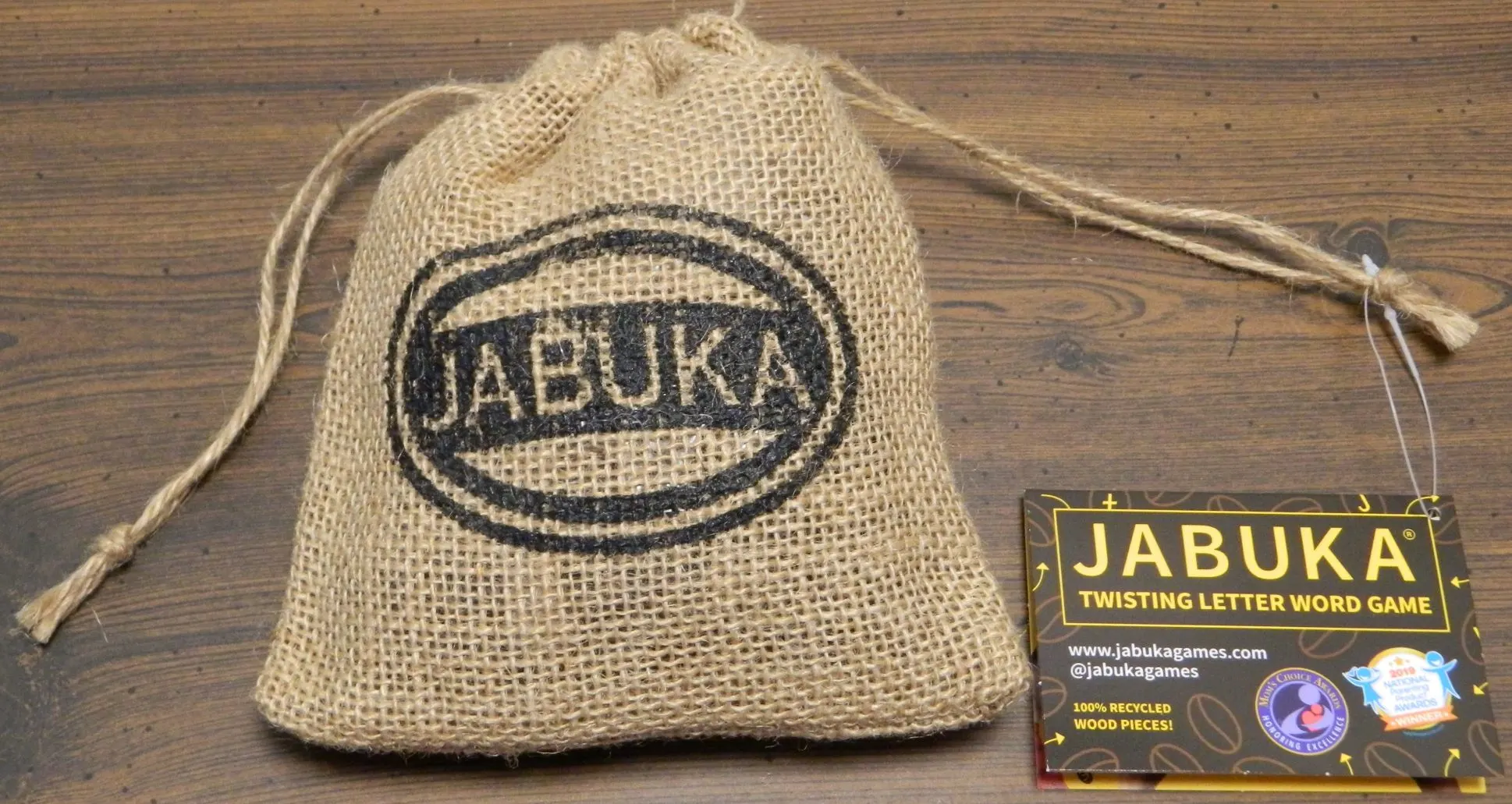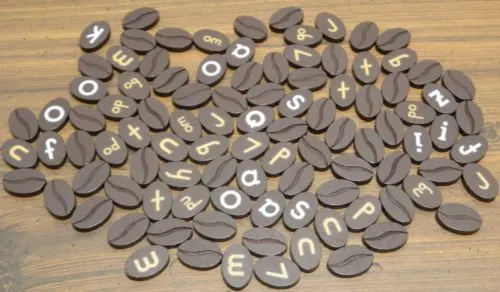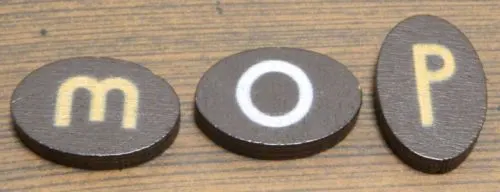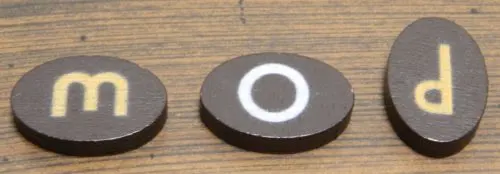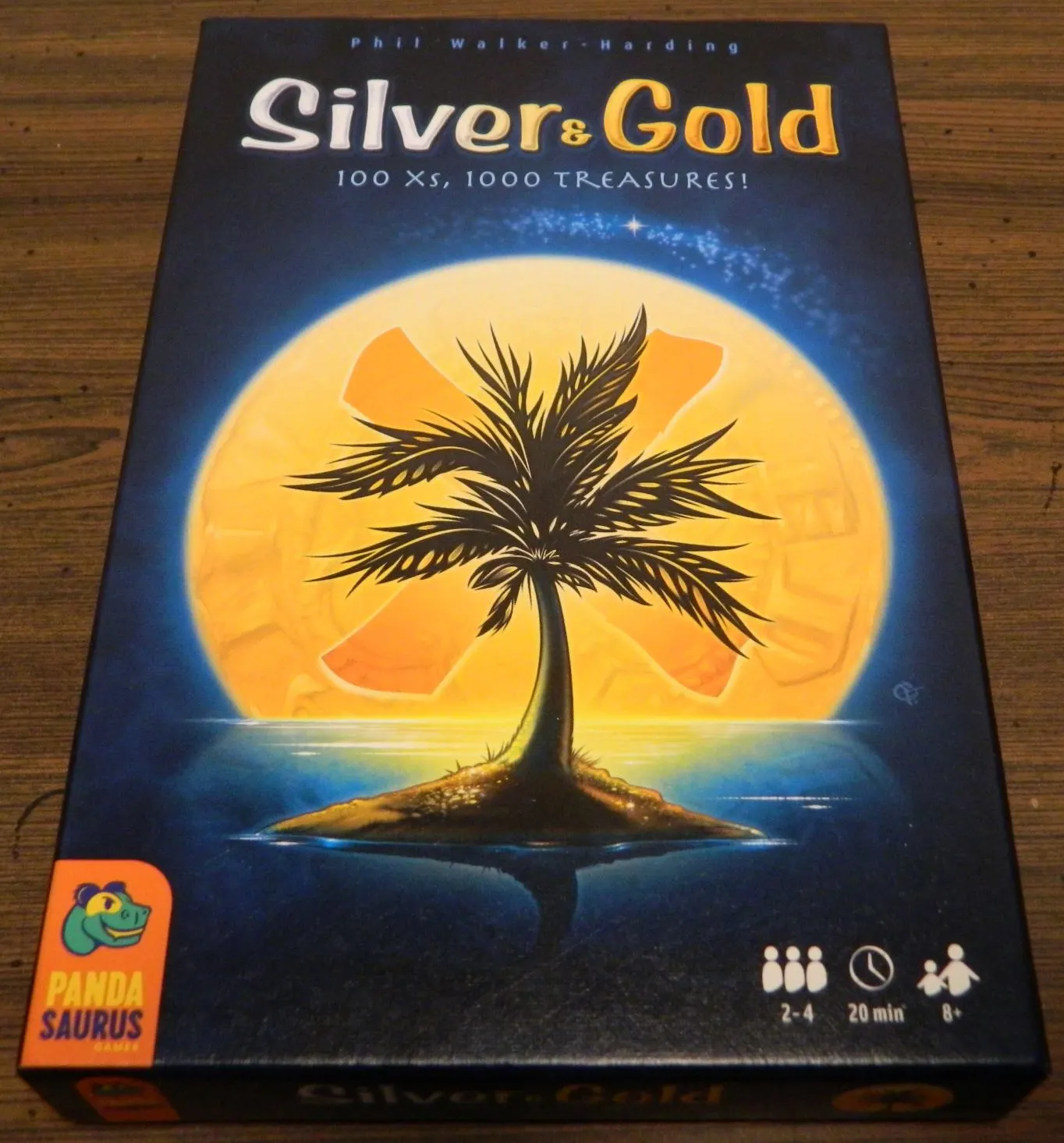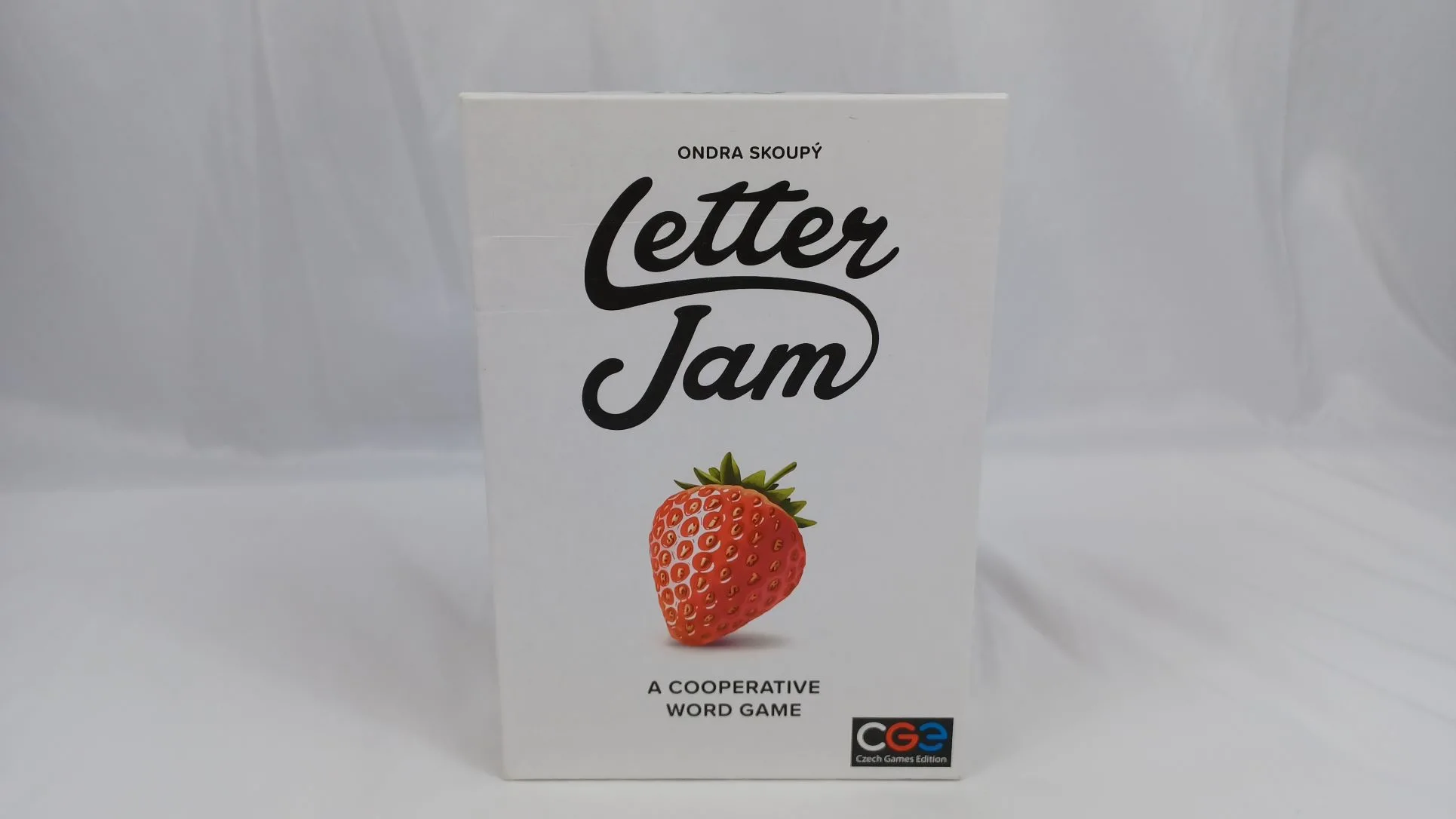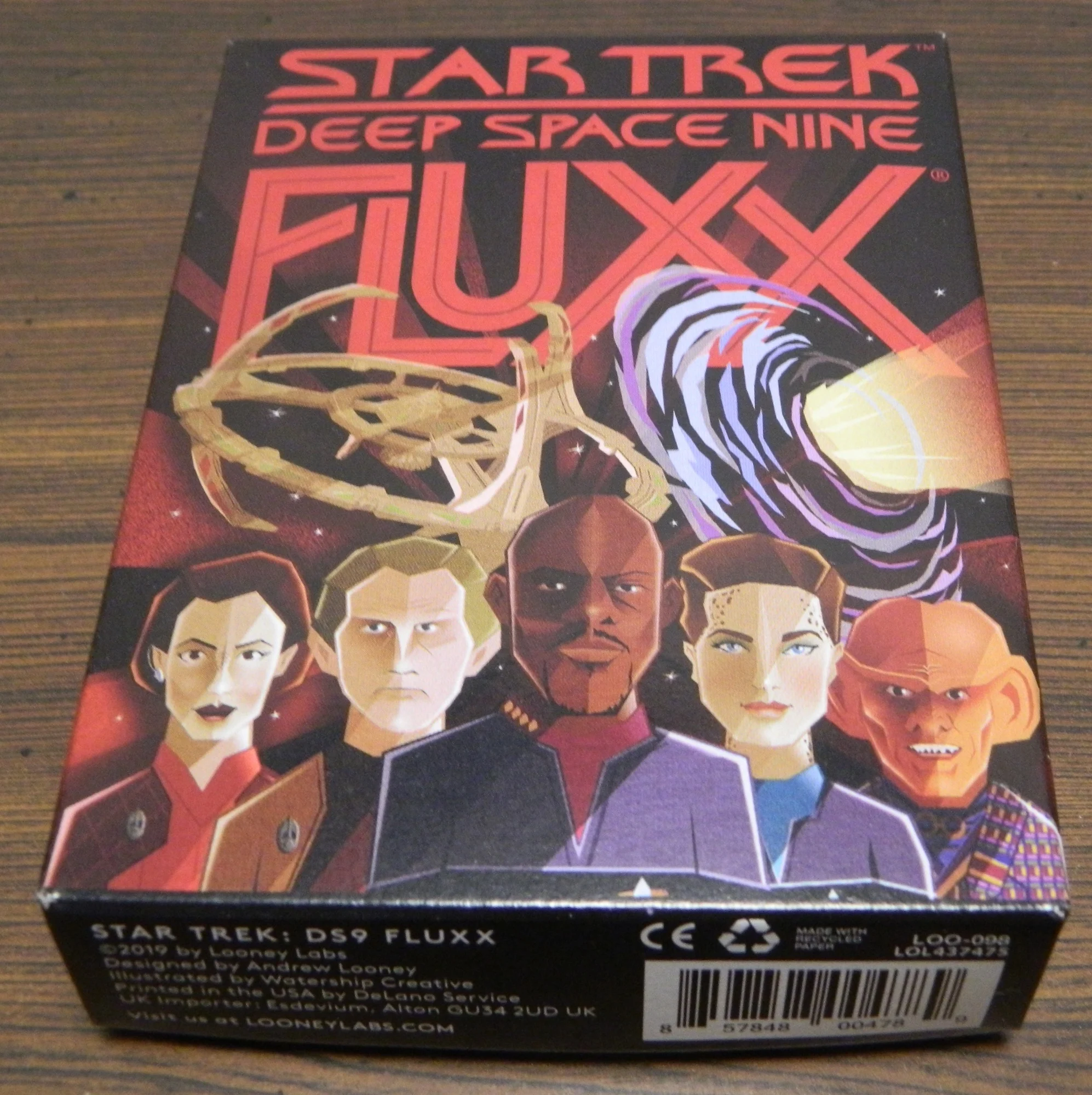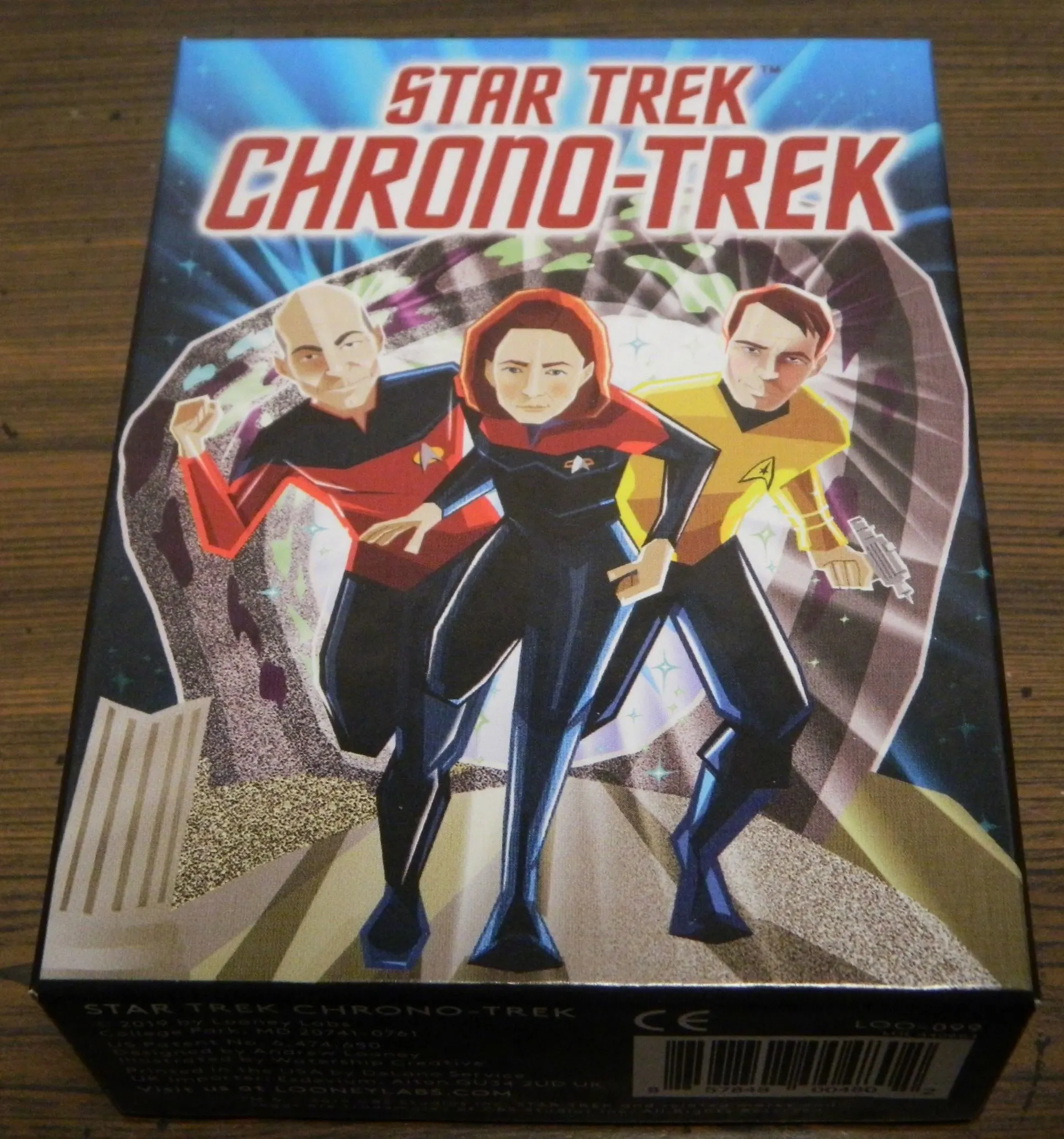The word game genre is arguably one of the most popular board game genres. Ever since Scrabble was created back in 1948 the word game genre has had a lot of fans. From book worms to people who just like simple straightforward board games there are many people that love the genre. At the same time though there are a lot of people that don’t really care for word games. I would classify myself as somewhere in-between. Word games (spelling games in particular) aren’t my favorite genre, but I don’t mind occasionally checking out a word game. When I saw Jabuka I was curious as it looked like an interesting idea. Jabuka shares a lot in common with your typical tile based word game, but twists the formula to create an interesting word game that fans of the genre should enjoy.
We would like to thank Jabuka Games Inc for the review copy of Jabuka used for this review. Other than receiving the review copy we at Geeky Hobbies received no other compensation. Receiving the review copy had no impact on the content of this review or the final score.
How to Play Jabuka
Setup
- Jabuka can either be played by two players or the players can join two teams.
- Spill the beans on the table. It doesn’t matter that some will land face up while others land face down. Make sure none of the beans are on top of one another though.
- Each player will take two light colored blank beans. These blanks will act as wilds for the rest of the game. The rest of the light colored blank beans will be added back to the bag.
Forming and Stealing Words
Jabuka is a simultaneous game. Players/teams don’t take turns as both can try to form and steal words at the same time.
Players will look at the beans in the middle of the table and try to come up with a word using the face up letters. White letters can only be used in one way. Letter and double letter beans that are in yellow can be twisted in order to form several different letters/letter combinations.
When a player/team thinks they can form a word they will shout out the word. Players can’t form words with just one bean. Proper names and acronyms also don’t count. They will then take the corresponding beans and place them in front of themselves. Players can also use one of their blank beans which counts as any letter. Whenever a player sees a word in the face up beans in the center of the table they can shout it out as players don’t take turns.
After words have been formed players can alter them. If you see an opportunity to alter or add to one of the other player’s words you can steal it and place the new word in front of yourself. In the game there are three ways to change a word and steal it from another player. You can use one or more of these at the same time to steal a word. The three ways to alter a word include:
- Twisting: A player can twist one of the yellow letters to turn it into another letter.
- Adding: A player can add one or more letters to a word.
- Rearranging: A player can rearrange the letters in a word to form a new word.
When stealing or forming a word players must follow these rules:
- All words must be placed in a way that the other player/team can easily see them.
- When stealing a word you must use all of the beans that were in the previous word.
- A player may add letters to their own words to make them harder to steal. A player may not rearrange or twist beans in their own words though.
- To change words you can either use letters in the center of the table or one of your blank beans.
- If both players/teams come up with the same word at the same time the player/team to grab the beans first will get the word.
- If a player can’t remember what letter their blank bean represents they must return the word to the center of the table face down.
- When you take a word from the other player/team you can assign a different letter to a blank bean.
- Words can be changed as many times as players want. Players may never change a word back to a word that it previously was.
- Players may form the same word multiple times during the game.
- If one of the players/teams don’t think a word is real they can challenge it. If the word turns out not to be real the player will return the beans to the center of the table face down.
Flipping Beans
When a player thinks there are no other ways to use the beans in the center of the table to create new words or change words they can say “flip”. If the other player/team agrees with them each player will take two of the face down beans and flip them over to their letter side. If you are playing teams only one player from each team will flip over beans. Players will then try to form new words or change words based on the new face up beans.
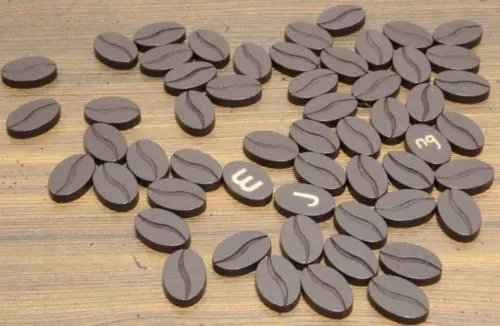
The players can’t think of a way to use the remaining face up beans. They will both choose two beans and flip them over to give themselves more options.
Whenever players are stuck they will flip over new beans. This will continue until all of the beans have been flipped over. After this last flip one last word will be formed or stolen. The player to make this last move will yell out “Jabuka”. The game will then end. If the players can’t form or change a word based on this last flip both players can agree to end the game.
The players will then count up the number of beans used in the words in front of them. The player/team that used more beans wins the game. If there is a tie the tied players will randomly draw ten beans. The player that forms the longest word with those ten beans wins the game. If there is still a tie the winner of best of three ten bean rounds will win the game.
My Thoughts on Jabuka
When most people see Jabuka their first thought is likely going to go straight to Scrabble or other similar tile based word games. This makes a lot of sense as Jabuka does share a lot in common with many other word games. Basically the beans are dropped in the middle of the table and players need to try to form words with the face up letters. Outside of the beans having a twist to them which I will address later, this element of the game plays a lot like Scrabble, Bananagrams, and quite a few other word games.
For this reason your opinion of Jabuka will likely depend on your opinion of word games in general. As much of the gameplay revolves around looking at a bunch of letter tiles and trying to form words from them it obviously won’t appeal to people that don’t like these type of games. Those that love word games though should really enjoy Jabuka. This mechanic maintains all of the elements that fans of this genre enjoy. The only real difference is with how you score points in the game. Players with stronger vocabularies will have an advantage in the game, but that is the same with every word game.
If this was all there was to Jabuka I would think it was a solid game, but there wouldn’t be anything particularly original about the game. The good news is that this isn’t all there is to the game. While the word mechanics are the driving force behind the game there are a couple of other mechanics that tweak the formula and turn Jabuka into a unique experience.
The first addition to your typical word game is the speed element. This isn’t totally original as there are a number of other word games that utilize a speed mechanic. Basically there are no turns in Jabuka. Both players/teams play at the same time. Thus you don’t have a bunch of time to think of the perfect word. If you take too long to form words the other player is likely to take the beans before you are able to use them. Generally you are better off claiming any word that you can see instead of wasting time trying to come up with a better word.
The speed mechanic doesn’t drastically change the game, but I think it was a good addition. I am usually a fan of speed mechanics as they pick up the pace and require players to think on their feet. While the players with the largest vocabularies are still likely to have an advantage in the game, this speed element neutralizes that advantage some. If you have a great vocabulary you are more likely to form larger words that are harder to steal, but you could lose out on the necessary beans before you can form the word. This speed element gives players a reason to form shorter words. It also speeds up the game as you don’t have to wait for another player to decide on what word they are going to form. The game still has some analysis paralysis problems, but they seem significantly smaller than many word games. While I enjoyed the speed mechanic I can see some people finding it stressful as you don’t have a lot of time to think.
Lets move onto the other addition that differentiates Jabuka from other word games. In addition to a speed mechanic the game also includes a take that/stealing mechanic. This is the mechanic that I think really differentiates Jabuka. Basically none of the words you form during the game are safe. If the other player/team can find a way to change up one of your words, while still using all of the beans that a currently comprise the word, they can steal the word from you. You might be really quick in forming words, but you also want to form words that are hard to steal.
The first two ways of changing up words are pretty straightforward. First you can just rearrange the letters in a word to form another word. Especially with shorter words this is surprisingly easy to do. You also have the ability to add letters to a word. In particular making a word plural or changing it into another tense is pretty easy most of the time. When forming words you want to try to avoid allowing a word to be pluralized as just adding an “s” to a word allows the other player to steal it.
The most unique way of stealing words though is by utilizing the beans themselves. Jabuka ultimately has three types of beans. There are white letters which are used like your typical tiles in a generic word game. Then there are the single and two letter beans that are yellow. These yellow beans are arguably the most unique mechanic in Jabuka. Basically all of the letters in yellow were designed in a way that they can represent two or more different letters. For example a “m” tile can also be a “w” or even an “E”. If you can twist one of the letter beans into another letter it allows you to steal a word from the other player.
At first I have to admit that I was a little skeptical about this mechanic. I didn’t think it would work all that well as I thought it would be hard to tell what letters a bean could be used as leading to the mechanic not being used all that much. There is the occasional instance where it is sometimes hard to tell what letters a bean can represent, but the more you play the game the more you start to adjust to this. Otherwise I thought the mechanic worked pretty well. It turns out that 2/3 of the beans feature yellow letters so there are plenty of opportunities to use this mechanic to change up words. This is actually a pretty clever mechanic as it allows each bean to represent several letters at the same time giving players a lot of different options. I wouldn’t say that it has a significantly larger impact on the game than being able to add or rearrange beans, but players that can utilize the mechanic well will have an advantage in the game.
This take that/stealing mechanic has a big impact on the game. Forming a lot of words quickly for yourself is important, but stealing words seems to be just as important. Being able to look at the other player’s words and figure out a way to twist and rearrange them is really important to the game. The player that is able to steal more words is likely going to win the game. In some ways Jabuka can be kind of mean. You could form a lot of words just to have the other player steal them from you. I can see this mechanic turning off some players as you are usually better off trying to steal the other player’s words instead of forming new words. Towards the end of the game you end up spending most of your time trying to steal words from the other player. I am usually not a huge fan of take that mechanics, but I thought they worked pretty well in Jabuka. They force players to stay on their toes looking for steal opportunities, and it adds quite a bit of player interaction to the game.
Being able to steal words from the other player is one of the most important mechanics in the entire game. The reason that the mechanic is so important is that it drives most of the strategy in the game. There are basically two different ways of approaching Jabuka. First you can approach it like a speed game where you try to form many words as quickly as you can. This allows you to control a bunch of letter tiles and limits how the other player can later use them. Short words are not easy to defend though. It is really easy to form three letter words, but it is almost as easy to add or change a letter or two and steal them. It takes more time to form longer words but they are also much easier to defend. Each letter that is used makes it considerably harder to steal a word. Once you form a long word you likely will be able to keep it for the rest of the game. While there are two different approaches to Jabuka, neither on their own is a good strategy. The key to doing well in the game is finding the right balance between shorter and longer words. Like most word games Jabuka isn’t a highly strategic game, but it has more strategy than I initially expected.
Jabuka has a decent amount of strategy, but I think one of its greatest strengths is the fact that the game is quite easy to play. The game has a number of more minor rules that you have to keep track of and it takes some time to adjust to twisting the letters. Otherwise Jabuka is quite simple. Basically the game is your typical word game that has added in a speed and stealing mechanic. The mechanics are quite straightforward where they can be taught in just a couple minutes. Basically anyone who can spell shouldn’t have too much trouble with the game. The game has a recommended age of 8+ which seems about right as younger children might not have strong enough spelling skills. I could see Jabuka being used to teach younger children spelling skills though as you could just play the game with shorter and easier to spell words.
In addition to being easy to learn I think Jabuka should play pretty quickly. The length of a game is ultimately going to depend on the individual players, but I would guess most games will take around 15-30 minutes. Jabuka is kind of strange because it feels like it has two distinct phases. To begin the game it is pretty much a free-for-all. As there are a bunch of face up beans in the middle of the table, players have a bunch of options. Players can quickly form a bunch of words and steal words from the other player. This continues until the number of face up beans in the middle of the table dwindle. This leads to the second phase of the game which is more methodical. As there are few face up beans in the middle of the table the game is now more about finding the few words that you can form with the letters in the middle of the table as well as trying to steal words from the other player. At this point in the game you will probably be spending a large majority of your time trying to steal words from the other player.
This is where much of the game’s length will be determined. Jabuka has a number of breakpoints built into the game where there are no letters to use to create new words or add to words already formed. At this point there isn’t much that players can do. This is where analysis paralysis can creep into the game. Basically to flip over more beans both players have to agree. If one of the players are obsessed with trying to find every possible word this could really extend the game. If you waste a bunch of time trying to find every possible word the game will really start to drag. While the game has no set time limit I personally would recommend setting some limit to keep the game moving. If neither player can find a new word or change a word within a couple minutes the players should be forced to turn over new beans so players don’t just sit there trying to find any possible word to try to steal a word from the other player.
As for the Jabuka’s components I liked them for the most part. All of the beans in the game are made from recycled wood. I generally like when board games use wood pieces as they feel nicer than plastic pieces. The wood beans in Jabuka are pretty nice. They are pretty thick so they should be durable. The ridges on the back of the beans also make them look like coffee beans. My main complaint with the components is with the letters themselves. For the most part I think the letters are made in a clever way as they can be used for two or more different letters. Some of these are easier to see than others though. Mostly I just wish the letters were engraved so they would be less prone to wear. There is no fading in the letters from the copy I received, but I worry that with extended play they may start to fade off after a while. Otherwise the game comes in a woven bag which is pretty nice as it looks like a bag that coffee beans would be stored in. The bag is also quite small which will make Jabuka a great travel game.
I had fun with Jabuka, but I think the game has a couple areas where it could have been a little better.
First based on my experience I would highly recommend playing the game on a smaller surface where the two players can sit pretty close to one another. In Jabuka you have to always be able to see the tiles in the middle of the table, your own words, as well as the words formed by the other player. If you play the game on a larger table this will be considerably harder to do. In particular at times it was kind of hard to figure out how to manipulate the other player’s letters which is made worse by players being further separated. I would actually recommend having both players sit on the same side of the table if possible. When players sit on opposite sides of the table all of the letters will be upside down which makes it even harder to find ways of manipulating them in order to steal a word as you have to reverse all of them inside your head. If the two players sit next to one another all of the beans can be facing one direction which will make it easier to find ways to manipulate the letters.
Otherwise I think Jabuka could use a few house rules in order to fix a few minor issues. First I would highly recommend implementing a time limit to reduce analysis paralysis like I mentioned above. In addition though I think players should agree to some ground rules on what words can be formed. While it is allowed in the rules I am not a big fan of being able to steal a word just by pluralizing it. A player could form a word just to have the other player steal it by adding a “s”. This is even worse when you can use one of your wilds to pluralize a word. While you could just wait to form the word until you can pluralize it, that is not always an option. Players can then just wait for a “s” to be revealed in order to take control of the word. I would at least consider getting rid of the ability to steal a word by pluralizing it or at least not allowing a player to use a wild to do it. Otherwise there are a couple other minor issues that could maybe be tweaked with some house rules.
Should You Buy Jabuka?
At first glance many people are going to think that Jabuka just looks like your typical tile based word game. That makes sense as it does share a lot in common with most tile word games. Basically you are tasked with forming words based on the face up letters. For this reason your enjoyment of Jabuka will likely depend on your opinion of word games in general. In addition Jabuka adds a number of other mechanics. First there is the addition of a speed mechanic as players don’t have to take turns. The game is a free-for-all as players need to think quickly to utilize beans before the other player can. The bigger addition is the ability to steal words from the other player/team. You can steal words by rearranging and/or adding letters to a word. The most interesting way though is by twisting letters as a majority of the letters in the game represent two or more letters. This makes the stealing mechanic key to the game as you likely will steal almost as many words as you form in the game. This is an interesting mechanic even though it can be a little harsh at times. Ultimately Jabuka doesn’t revolutionize the word game genre, but it creates an interesting twist on the formula that I enjoyed playing.
My recommendation mostly comes down to your opinion of word games in general as well as Jabuka’s premise. If you don’t generally like word games or don’t care for the speed or stealing mechanics I don’t think Jabuka will be for you. Fans of word games though or those that think the premise sounds interesting should enjoy Jabuka. If Jabuka’s premise intrigues you I would recommend picking it up.
Buy Jabuka online: Amazon

